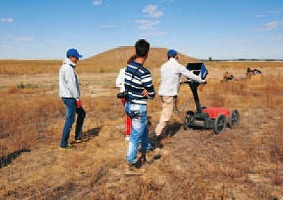
NABUNKEN NEWS vol.47
Prospection of archaeological sites with Central Asian people
The Republic of Kazakhstan is an extremely large country located to the south of Russia, sharing a border with China in the east, and extending to the Caspian Sea in the west. Although the term "Silk Road" may remind you of images of vast deserts and wastelands, if you arrive at the Almaty International Airport, you will be surprised at the prolification of cars, people and goods, making it appear not much different to Japan. The level of Kazakhstan's development actually surprised me.
From September 18 to 26, in cooperation with the Tokyo National Research Institute for Cultural Properties we participated in an international workshop held by the UNESCO/Japan Funds-in- Trust as a part of the Silk Road Support Project.
There were two participants from the Nara National Research Institute for Cultural Properties; MORIMOTOSusumu, the Head of the International Cooperation Section, and myself. There we introduced and explained methods of archaeological prospection and usage of geophysical equipment to researchers from Central Asia.
Partly because this is the second year in which the workshop has been held, the Kazakh counterpart has already purchased the equipment and materials for arcaheological prospection, and their understanding of basic methods of measurement methods and analyses was sufficient. Consequently, in contrast to the workshop held during the first year, we were able to hold the lectures and actual measurement training in the field, focusing on more practical issues. In addition, we discussed about analysis using software and its results. For example, ground penetrating radar is a technology which is quickly being implemented in a range of fields, including the identification of underground piping and resource mapping. Even so, to retrieve the essential information about an archaeological site using this equipment, we need to establish a methodology suited to the purpose. By trying the equipment together and listening to the explanations of our experiences in Japan, participants seemed to understand the importance of "cut-and-try" to establish a proper method for each kind of land and target.
Many participants were young men in their 20s and 30s; and, as was the case with the last workshop, they caught me with a barrage of questions which extended past the time limit. I returned to Japan, looking forward to a future opportunity to be able to see the work they achieve across central Asia within a few years, as well as cautioning myself not to easily lose the lead to them.
(KANEDA Akihiro, Center for Archaeological Operations)
 Site exploration in Kazakhstan |
